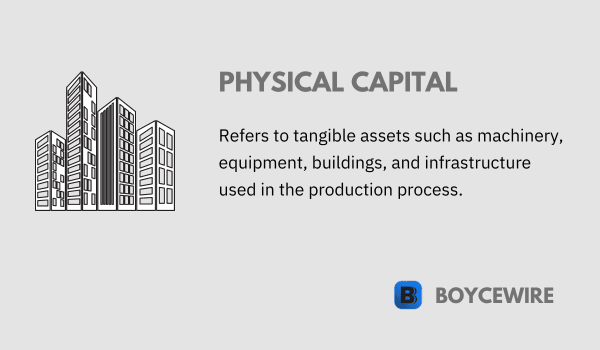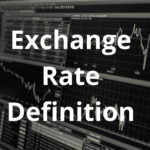Table of Contents ![]()
Physical Capital: Definition, Types & Examples

What is Physical Capital?
Physical capital is a crucial component of any economy, as it encompasses the tangible assets that are used in the production of goods and services. These assets include buildings, infrastructure, machinery, equipment, vehicles, and technology, all of which play a significant role in economic growth and development.
As economies evolve, the need for increased investment in physical capital becomes more critical, as it helps to improve productivity, create jobs, and raise living standards. Its importance cannot be overstated, as it has a direct impact on a nation’s ability to produce goods and services efficiently. As such, the accumulation and maintenance of physical capital are essential for the long-term prosperity of any economy.
Key Points
- Physical capital refers to tangible assets used in the production process, including machinery, equipment, buildings, infrastructure, and tools.
- It plays a crucial role in enhancing productivity and economic growth by enabling businesses to produce goods and services more efficiently.
- Physical capital is accumulated through investment, as businesses and individuals allocate resources to acquire or produce physical assets.
Types of Physical Capital
Physical capital can be broadly categorized into two main types: fixed capital and working capital. Understanding the differences between these categories is essential for comprehending the role each type plays in the production process.
Fixed Capital:
Fixed capital refers to the long-term, non-consumable assets used in the production of goods and services. These assets have a useful life of more than one year and are typically more expensive to acquire. Fixed capital includes:
- Buildings: Factories, warehouses, office buildings, and retail spaces where production, storage, and administrative activities take place.
- Infrastructure: Roads, bridges, ports, airports, and communication networks that enable the smooth functioning of an economy by facilitating the transportation of goods and people.
- Machinery and Equipment: Industrial machines, tools, and equipment used to manufacture goods, as well as vehicles and office equipment necessary for business operations.
- Technology: Computers, software, and other digital tools that support and enhance the productivity of businesses and the economy as a whole.
Working Capital:
Working capital refers to the short-term, consumable assets used in the day-to-day operations of a business. These assets are continually utilized and replaced within a year, making them critical for maintaining the ongoing functioning of a business. Working capital includes:
- Raw Materials: The inputs required for the production of goods, such as metals, chemicals, textiles, and agricultural products.
- Work-in-Progress: Partially completed goods that are in the process of being transformed into final products.
- Finished Goods: Completed products that are ready for sale but have not yet been sold.
- Cash and Short-term Investments: Liquid assets that can be easily converted into cash to meet short-term financial obligations.
Both fixed and working capital are vital for the efficient operation of businesses and the overall economy, as they support the production process and contribute to economic growth.
Physical Capital Examples
Physical capital encompasses a wide range of tangible assets that are employed in the production of goods and services. To illustrate the diverse nature of physical capital, here are some examples from various industries:
Agriculture:
- Tractors and other farming machinery used for plowing, planting, and harvesting crops.
- Irrigation systems for delivering water to crops.
- Greenhouses and other structures for growing and nurturing plants.
Manufacturing:
- Assembly lines and conveyor belts for producing goods on a large scale.
- Robotics and automation systems for increasing efficiency and reducing labor costs.
- Injection molding machines for creating plastic components.
Retail and Service:
- Retail stores, restaurants, and other commercial spaces where goods and services are sold to consumers.
- Cash registers, point-of-sale systems, and other equipment used for processing transactions.
- Vehicles for transporting goods, such as delivery trucks and vans.
Transportation and Logistics:
- Airports, railways, and seaports for moving goods and people between locations.
- Trucks, trains, ships, and airplanes for transporting cargo and passengers.
- Warehouses and distribution centers for storing and managing inventory.
Information Technology and Telecommunications:
- Data centers and servers for storing and processing digital information.
- Fiber optic cables and satellite networks for transmitting data and communication signals.
- Computer hardware and software for managing and analyzing data, as well as for designing new products and services.
These examples demonstrate the various forms of physical capital used across different industries. The investment in and maintenance of physical capital are crucial for businesses to remain competitive and for the overall growth of the economy.
Characteristics of Physical Capital
- Tangibility: refers to tangible assets. These are assets that physically exist and can be touched, such as machinery, buildings, and vehicles. They are in stark contrast to intangible assets like patents, brand recognition, and intellectual property.
- Durability: Unlike raw materials that are consumed in the production process, physical capital is durable. Its value depreciates over a longer period, often over several years or even decades. Durability, however, also means that the initial investment in physical capital can be quite high.
- Capital-Intensive nature: The term “capital-intensive” is often used to describe industries or sectors where the production process relies heavily on physical capital. In these industries, such as manufacturing and transportation, significant investments in such capital are required to start and maintain operations.
- Depreciation: Over time, it tends to lose value through a process known as depreciation. This can occur due to physical wear and tear, technological obsolescence, or market factors. Businesses must account for depreciation when calculating their net income and when making decisions about capital expenditure.
Physical Capital and Business Strategy
The role of physical capital in business strategy is significant, as it can directly affect a company’s capacity to produce goods or services, impact cost structures, and influence competitiveness in the market. Here are some ways it plays into business strategy:
- Scale of Operations: The amount and type of physical capital a company owns can determine the scale of its operations. For instance, a manufacturing company with more machinery can produce more goods, potentially gaining a competitive advantage through economies of scale.
- Capital Expenditure Decisions: Businesses need to make strategic decisions about capital expenditures, i.e., investments in physical capital. These decisions are typically based on the expected return on investment and can significantly influence a company’s future profitability and competitive position.
- Technological Upgrades: In many industries, staying competitive means keeping up with technological advancements. Investing in updated capital can lead to increased productivity and efficiency, reducing costs, and improving product quality.
- Asset Utilization: Effective utilization of such capital is another strategic consideration. This can involve deciding when to run machinery, how to maintain equipment to minimize downtime, and when it might be more cost-effective to lease or sell unused assets.
- Depreciation and Replacement: Understanding and planning for depreciation is crucial. Over time, such capital wears out or becomes outdated. A business needs to strategically plan for the replacement of these assets while balancing the financial impacts.
The integration of physical capital into business strategy thus requires careful consideration. Decisions about physical capital can have long-term implications for a business, influencing not only its production capabilities but also its financial health and competitive positioning.
FAQs
Physical capital refers to tangible assets used in the production process, such as machinery, equipment, buildings, infrastructure, and tools.
Physical capital represents the physical assets utilized in production, while human capital refers to the knowledge, skills, and abilities of individuals that contribute to economic productivity.
Physical capital is essential for enhancing productivity and economic growth. It enables businesses to produce goods and services more efficiently, leading to increased output and improved living standards.
Physical capital refers to tangible assets, whereas financial capital refers to monetary resources, such as money, stocks, bonds, and investments, that are used to acquire such capital and finance economic activities.
About Paul
Paul Boyce is an economics editor with over 10 years experience in the industry. Currently working as a consultant within the financial services sector, Paul is the CEO and chief editor of BoyceWire. He has written publications for FEE, the Mises Institute, and many others.

Further Reading
 Exchange Rate: Definition, Causes, Effects & Types - An exchange rate is the value by which two currencies are swapped with each other.
Exchange Rate: Definition, Causes, Effects & Types - An exchange rate is the value by which two currencies are swapped with each other.  Due Diligence - Due diligence is a comprehensive investigation and analysis process conducted to assess risks, verify information, and evaluate the viability and…
Due Diligence - Due diligence is a comprehensive investigation and analysis process conducted to assess risks, verify information, and evaluate the viability and…  San Francisco’s Homeless Crisis - The homeless rate in San Francisco reached over 9,700 people in 2019. That is an increase of 30 percent in…
San Francisco’s Homeless Crisis - The homeless rate in San Francisco reached over 9,700 people in 2019. That is an increase of 30 percent in… 
